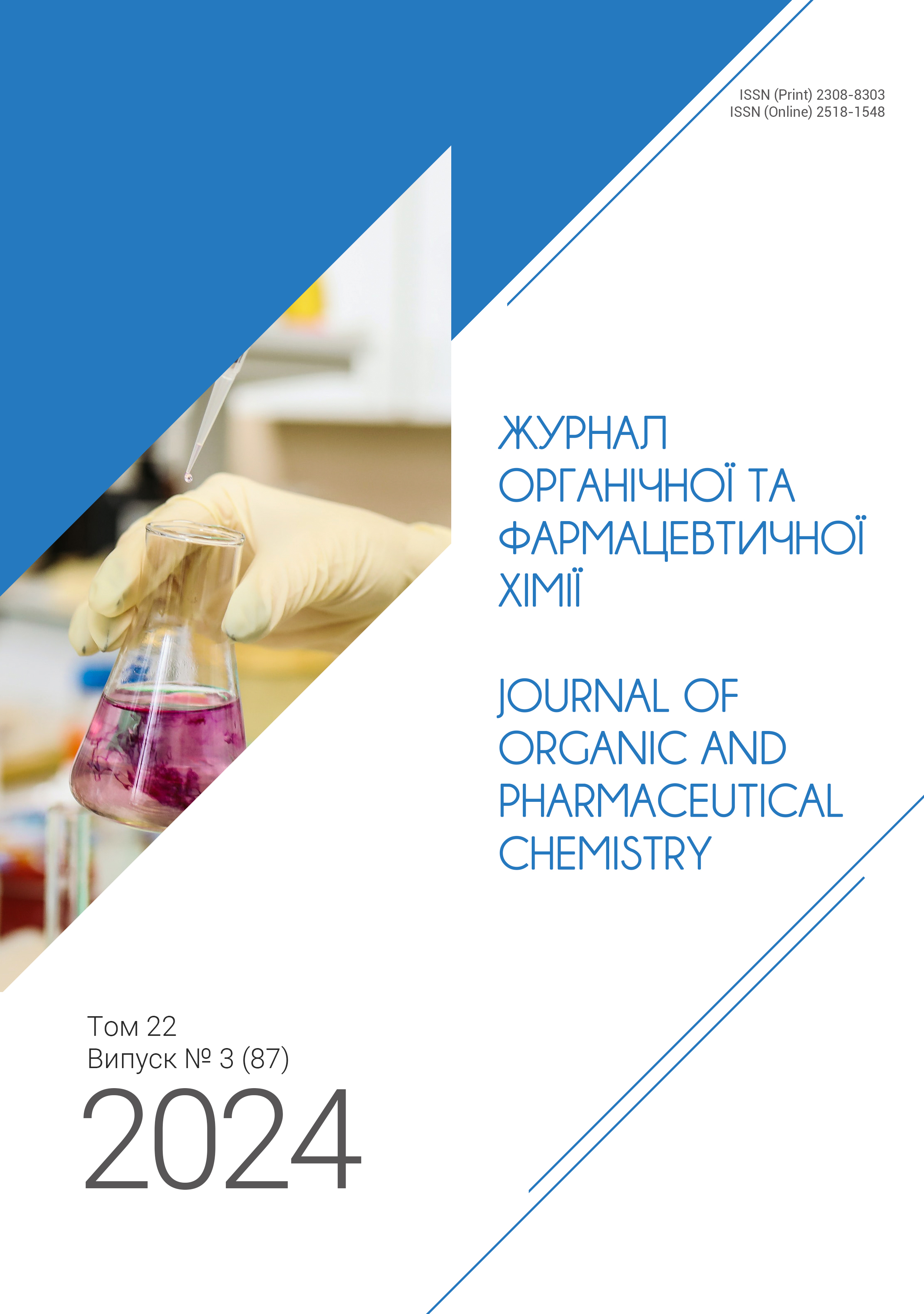Synthesis and Physicochemical Characteristics of 6,6-Difluorobicyclo[3.2.0]heptane Derivatives
DOI:
https://doi.org/10.24959/ophcj.24.314176Keywords:
fluorine, bicyclic compounds, acidity, lipophilicity, building blocksAbstract
The gram-scale synthesis of 6,6-difluorobicyclo[3.2.0]heptane-derived building blocks (i.e., primary amine and carboxylic acid) was performed via the deoxofluorination of the corresponding bicyclic keto ester with diethylaminosulfur trifluride (DAST). Physicochemical properties of the compounds obtained (i.e., pKa) or their model benzamide / anilide derivatives (i.e., LogP) were determined experimentally and compared to those of monocyclic and non-fluorinated bicyclic counterparts. It was found that gem-difluorination expectedly decreased the pKa values by 0.3 - 0.5 units, whereas the LogP values were decreased by 0.54 - 0.55 units. Meanwhile, the bicyclic system itself had a negligible impact on the compounds’ acidity and lipophilicity compared to the monocyclic counterparts.
Supporting Agency
- The work was supported by Enamine Ltd., Ministry of Education and Science of Ukraine (grant No. 0122U001962 (22BF037-02)), and the National Academy of Sciences of Ukraine (grant No. 0119U102718).
Downloads
References
- Grygorenko, O. O.; Melnykov, K. P.; Holovach, S.; Demchuk, O. Fluorinated Cycloalkyl Building Blocks for Drug Discovery. ChemMedChem 2022, 17 (21). https://doi.org/10.1002/cmdc.202200365.
 |
|  |
| 
- Ryabukhin, S. V.; Bondarenko, D. V.; Trofymchuk, S. A.; Lega, D. A.; Volochnyuk, D. M. Aza‐Heterocyclic Building Blocks with In‐Ring CF2 Fragment. Chem. Rec. 2023, 24 (2). https://doi.org/10.1002/tcr.202300283.
 |
|  |
| 
- de Sena M. Pinheiro, P.; Rodrigues, D. A.; do Couto Maia, R.; Thota, S.; Fraga, C. A. M. The Use of Conformational Restriction in Medicinal Chemistry. Curr. Top. Med. Chem. 2019, 19 (19), 1712 - 1733. https://doi.org/10.2174/1568026619666190712205025.
 |
|  |
| 
- Borsari, C.; Rageot, D.; Dall’Asen, A.; Bohnacker, T.; Melone, A.; Sele, A. M.; Jackson, E.; Langlois, J.-B.; Beaufils, F.; Hebeisen, P.; Fabbro, D.; Hillmann, P.; Wymann, M. P. A Conformational Restriction Strategy for the Identification of a Highly Selective Pyrimido-Pyrrolo-Oxazine MTOR Inhibitor. J. Med. Chem. 2019, 62 (18), 8609 - 8630. https://doi.org/10.1021/acs.jmedchem.9b00972.
 |
|  |
| 
- Grygorenko, O. O.; Volochnyuk, D. M.; Ryabukhin, S. V.; Judd, D. B. The Symbiotic Relationship between Drug Discovery and Organic Chemistry. Chem. - Eur. J. 2019, 26 (6), 1196 - 1237. https://doi.org/10.1002/chem.201903232.
 |
|  |
| 
- Semeno, V. V.; Vasylchenko, V. O.; Vashchenko, B. V.; Lutsenko, D. O.; Iminov, R. T.; Volovenko O.; Grygorenko, O. O. Building the Housane: Diastereoselective Synthesis and Characterization of Bicyclo[2.1.0]Pentane Carboxylic Acids. J. Org. Chem. 2019, 85 (4), 2321 - 2337. https://doi.org/10.1021/acs.joc.9b03044.
 |
|  |
| 
- Moroz, B.; Melnykov, K. P.; Holovach, S.; Filatov, A. A.; Raievskyi, O.; Platonov, M.; Liashuk, O.; Volochnyuk, D. M.; Grygorenko, O. O. 6,6-Difluorobicyclo[3.1.0]Hexane as a Rigidified 4,4-Difluorocyclohexane Mimetic: Multigram Synthesis, Physicochemical Characterization, and Incorporation into Maraviroc Analogs. J. Fluorine Chem. 2023, 272, 110215 - 110215. https://doi.org/10.1016/j.jfluchem.2023.110215.
 |
| 
- Bychek, R. M.; Levterov, V. V.; Sadkova, I. V.; Tolmachev, A. A.; Mykhailiuk, P. K. Synthesis of Functionalized Difluorocyclopropanes: Unique Building Blocks for Drug Discovery. Chem. - Eur. J. 2018, 24, 12291 - 12297. https://doi.org/10.1002/chem.201705708.
 |
|  |
| 
- Greene, A. E.; Luche, M. J.; Serra, A. A. An Efficient, Enantioconvergent Total Synthesis of Natural Hirsutic Acid C. J. Org. Chem. 1985, 50 (21), 3957 - 3962. https://doi.org/10.1021/jo00221a001.
 |
| 
- Holovach, S.; Melnykov, K. P.; Skreminskiy, A.; Herasymchuk, M.; Tavlui, O.; Aloshyn, D.; Borysko, P.; Rozhenko, A. B.; Ryabukhin, S. V.; Volochnyuk, D. M.; Grygorenko, O. O. Effect of Gem-Difluorination on the Key Physicochemical Properties Relevant to Medicinal Chemistry: The Case of Functionalized Cycloalkanes. Chem. - Eur. J. 2022, 28 (19), e202200331. https://doi.org/10.1002/chem.202200331.
 |
|  |
| 
- Liashuk, O. S.; Fedinchyk, A.; Melnykov, K. P.; Herasymchuk, M.; Alieksieieva, D.; Lesyk, D.; Bas, Y. P.; Keda, T. Y.; Yatsymyrskiy, A. V.; Holota, Y.; Borysko, P.; Yarmolchuk, V. S.; Grygorenko, O. O. 3,3-Difluorooxetane – A Versatile Functional Group for Bioisosteric Replacements in Drug Discovery. Chem. - Eur. J. 2024, e202403277. https://doi.org/10.1002/chem.202403277.
 |
|  |
| 
- Semeno, V. V.; Vasylchenko, V. O.; Fesun, I. M.; Ruzhylo, L. Y.; Kipriianov, M. O.; Melnykov, K. P.; Skreminskyi, A.; Iminov, R.; Mykhailiuk, P.; Vashchenko, B. V.; Grygorenko, O. O. Bicyclo[m.n.k]Alkane Building Blocks as Promising Benzene and Cycloalkane Isosteres: Multigram Synthesis, Physicochemical and Structural Characterization. Chem. - Eur. J. 2024, 30 (12). https://doi.org/10.1002/chem.202303859.
 |
|  |
| 
- Armarego, W. L. F.; Chai, C. L. L. Purification of Laboratory Chemicals; Elsevier, 2009. https://doi.org/10.1016/c2009-0-26589-5.
Downloads
Additional Files
Published
How to Cite
Issue
Section
License
Copyright (c) 2024 National University of Pharmacy

This work is licensed under a Creative Commons Attribution 4.0 International License.
Authors publishing their works in the Journal of Organic and Pharmaceutical Chemistry agree with the following terms:
1. Authors retain copyright and grant the journal the right of the first publication of the work under Creative Commons Attribution License allowing everyone to distribute and re-use the published material if proper citation of the original publication is given.
2. Authors are able to enter into separate, additional contractual arrangements for the non-exclusive distribution of the journal’s published version of the work (e.g., post it to an institutional repository or publish it in a book) providing proper citation of the original publication.
3. Authors are permitted and encouraged to post their work online (e.g. in institutional repositories or on authors’ personal websites) prior to and during the submission process, as it can lead to productive exchanges, as well as earlier and greater citation of published work (see The Effect of Open Access).















